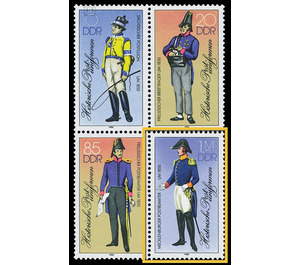Historic postal uniforms - Germany / German Democratic Republic 1986 - 100 Pfennig
Theme: Devices, Items & Instruments
| Country | Germany / German Democratic Republic |
| Issue Date | 1986 |
| Face Value | 100.00 |
| Color | multi-colored |
| Perforation | K 14 and K 12 1/2: 13 |
| Printing Type | Squeegee and offset |
| Stamp Type | Postage stamp |
| Item Type | Stamp |
| Chronological Issue Number | 2742 |
| Chronological Chapter | GER-DDR |
| SID | 369402 |
| In 19 Wishlists | |
Historic postal uniforms The Ministry of Posts and Telecommunications of the German Democratic Republic publishes four multicolored special postage stamps with illustrations of historical postal uniforms, one after the other and in se-tenant print. Special cancellations from 4 February to 3 April 1986 Historical postal uniforms The first Prussian uniform regulations issued under Frederick I first obliged only the higher post office officials to wear a gala uniform on public occasions and in the presence of the king. Under Frederick II, a further uniform order for all postal officials was taken, based on the already existing color combination of blue and orange. It was intended to counteract the sometimes unjustified high costs of many postmasters, but also the often inadequate garments of other postal administrators who violate the dignity of the service. The basic elements of the Prussian uniforms of this time have been preserved until the end of the 19th century. The dark blue skirt with metal buttons, orange-red stand-up collar and cuffs as well as rich gold embroidery was of military cut. To differentiate within the ranks served different Rockfütterungen that were visible in the open laps, but also different colors of pants and vest. Further differences were expressed by epaulettes, curbs, sword with associated portepee and decorative elements on the hats. A uniform order of 1817 also allowed postal clerks, postmen and postmen to wear embroidery on collars, cuffs and flaps, with new patterns being prescribed. In order to make the officials more accustomed to wearing the uniforms, it was stipulated in the conditions of acceptance of the year 1836 that the new postmen who had come into the service had to prove the means of purchase beforehand. Appointments to post-secretaries should not be pronounced until the higher-grade uniform was in place. The uniform regulations of 1851 distinguished between state and service uniform, whereby the yard and upper post secretaries, post office assistants and postexpediteurs were not obligated to wearing the state uniform. The Uniform Rules of 18 October 1871, issued after the founding of the Reich, left unchanged the gala (state) uniforms that had been handed down from the individual German states. The cut of the service poles was changed, which now received a turn-down collar of dark blue velvet with degree distinctions and on the cap on blue, orange-red piped stripes the imperial cockade and above a label with imperial eagle and post horn. The uniform of the Grand Ducal Mecklenburg-Schwerin post office officials around the middle of the 19th century determined for the daily service a dark blue skirt with a scarlet stand-up collar and gray trousers. In contrast, the interim uniform had a dark blue, single-breasted buttoned skirt with a stand-up collar and cuffs of scarlet cloth and long skirt tails, plus triangular hat and sword and portepee. The state uniform graced an additional gold embroidery on the collar, cuffs and flap; it was completed by tight-fitting cloth pants and tall boots with silver spurs. Gradual differences were expressed in the embossing of the buttons as well as in epaulettes, hat-line and embroidery (1.00-mark value).


